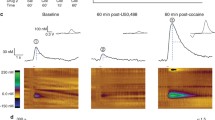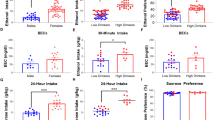Abstract
Rationale
Salvinorin A is a naturally occurring hallucinogen derived from the plant Salvia divinorum. Salvinorin A is also a potent and selective kappa opioid receptor agonist in vitro. It has been shown that kappa agonists decrease dopamine levels in the caudate putamen and nucleus accumbens and cause conditioned place aversion in rodents.
Objectives
To study the effects of salvinorin A on basal dopamine levels in the caudate putamen and nucleus accumbens, and to determine whether salvinorin A induces conditioned place preference or aversion and changes in locomotor activity in the mouse.
Methods
In the first experiment, changes in dopamine levels in these brain regions after administration of salvinorin A were measured with in vivo microdialysis. In the second experiment, we examined whether salvinorin A led to conditioned place preference or aversion, and changes in locomotor activity during conditioning sessions.
Results
The higher doses of salvinorin A studied (1.0 mg/kg and 3.2 mg/kg, i.p.) significantly decreased dopamine levels in the caudate putamen, but not in the nucleus accumbens, and this effect was completely blocked by pre-injection with 10 mg/kg of the kappa opioid receptor antagonist nor-binaltorphimine. The same doses of salvinorin A caused conditioned place aversion and decreased locomotor activity.
Conclusions
The inhibitory effect of salvinorin A on striatal dopamine levels may contribute to its induction of conditioned place aversion and decreases in locomotion in mice. These findings are consistent with the in vitro characterization of salvinorin A as a kappa opioid receptor agonist. It is of interest that a compound such as salvinorin A, that lowers striatal dopamine levels and leads to conditioned place aversion in rodents, is self-administered by humans under certain conditions.





Similar content being viewed by others
References
Bals-Kubik R, Herz A, Shippenberg TS (1989) Evidence that the aversive effects of opioid antagonists and kappa-agonists are centrally mediated. Psychopharmacology 98:203–206
Butelman ER, Harris TJ, Kreek MJ (2004) The plant-derived hallucinogen, salvinorin A, produces κ-opioid agonist-like discriminative effects in rhesus monkeys. Psychopharmacology 172:220–224
Cappell H, LeBlanc AE (1971) Conditioned aversion to saccharin by single administration of mescaline and d-amphetamine. Psychopharmacologia 22:352–356
Chavkin C, Sud S, Jin W, Steward J, Zjawinony JK, Siebert D, Toth BA, Hufeisen SJ, Roth BL (2004) Salvinorin A, an active component of the hallucinogenic sage salvia divinorum, is a highly efficacious kappa opioid receptor agonist: structural and functional considerations. J Pharmacol Exp Ther 308:1197–1203
Crawford DA, McDougall SA, Bolanos CA, Hall S, Berger SP (1995) The effects of the kappa agonist U-50, 488 on cocaine-induced conditioned and unconditioned behaviors and Fos immunoreactivity. Psychopharmacology 120:392–399
DePaoli AM, Hurley KM, Yasada K, Reisine T, Bell G (1994) Distribution of kappa opioid receptor mRNA in adult mouse brain: an in situ hybridization histochemistry study. Mol Cell Neurosci 5:327–335
Devine DP, Leone P, Pocock D, Wise RA (1993) Differential involvement of ventral tegmental mu, delta and kappa opioid receptors in modulation of basal mesolimbic dopamine release: in vivo microdialysis studies. J Pharmacol Exp Ther 266:1236–1246
Di Chiara G, Imperato A (1988) Drugs abused by humans preferentially increase synaptic dopamine concentrations in the mesolimbic system of freely moving rats. Proc Natl Acad Sci U S A 85:5274–5278
Donzanti BA, Althaus JS, Payson MM, Von Voigtlander PF (1992) Kappa agonist-induced reduction in dopamine release: site of action and tolerance. Res Commun Chem Pathol Pharmacol 78:193–210
Drug Enforcement Administration (2002) List of drugs and chemicals of concern. Internet website: http://www deadiversion usdoj gov/drugs-concern/salvia-d/summary.htm
Franklin KBJ, Paxinos G (1997) The mouse brain in stereotaxic coordinates. Academic Press, San Diego, CA
Glick SD, Maisonneuve IM, Raucci J, Archer S (1995) Kappa opioid inhibition of morphine and cocaine self-administration in rats. Brain Res 681:147–152
Glick SD, Visker KE, Maisonneuve IM (1998) Effects of cyclazocine on cocaine self-administration in rats. Eur J Pharmacol 357:9–14
Harvey JA (2003) Role of the serotonin 5-HT2A receptor in learning. Learn Mem 10:355–362
Heidbreder CA, Goldberg SR, Shippenberg TS (1993) The kappa-opioid receptor agonist U-69593 attenuates cocaine-induced behavioral sensitization in the rat. Brain Res 616:335–338
Institute of Laboratory Animal Resources Commission on Life Sciences, National Research Council (1996) Guide for the care and use of laboratory animals. National Academy of Sciences, Washington, DC
Jamensky NT, Gianoulakis C (1997) Content of dynorphins and kappa-opioid receptors in distinct brain regions of C57BL/6 and DBA/2 mice. Alcohol Clin Exp Res 21:1455–1464
Kitaichi K, Noda Y, Miyamoto Y, Numaguchi A, Osawa H, Hasegawa T, Furukawa H, Nabeshima T (1999) Involvement of the serotonergic neuronal system in phencyclidine-induced aversion in rats. Behav Brain Res 103:105–111
Kuzmin AV, Semenova S, Gerrits MAFM, Zvartau EE, Van Ree JM (1997) k-Opioid receptor agonist U50,488H modulates cocaine and morphine self-administration in drug-naïve rats and mice. Eur J Pharmacol 321:265–271
Maisonneuve I, Kreek MJ (1994) Acute tolerance to the dopamine response induced a binge pattern of cocaine administration in male rats: an in vivo microdialysis study. J Pharmacol Exp Ther 268:916–921
McGregor IS, Issakidis CN, Prior G (1996) Aversive effects of the synthetic cannabinoid CP55,940 in rats. Pharmacol Biochem Behav 53:657–664
Meehan SM, Schechter MD (1998) LSD produces conditioned place preference in male but not female fawn hooded rats. Pharmacol Biochem Behav 59:105–108
Meyer A, Mayerhofer A, Kovar KA, Schmidt WJ (2002) Rewarding effects of the optical isomers of 3,4-methylenedioxy-methylamphetamine (Ecstasy) and 3,4-methylenedioxy-ethylamphetamine (Eve) measured by conditioned place preference in rats. Neurosci Lett 330:280–284
Mori T, Nomura M, Nagase H, Narita M, Suzuki T (2002) Effects of a newly synthesized kappa-opioid receptor agonist, TRK-820 on the discriminative stimulus and rewarding effects of cocaine in rats. Psychopharmacology 161:17–22
Parker LA (1996) LSD produces place preference and flavor avoidance but does not produce flavor aversion in rats. Behav Neurosci 110:503–508
Robinson L, Hinder L, Pertwee RG, Riedel G (2003) Effects of delta9-THC and WIN-55,212-2 on place preference in the water maze in rats. Psychopharmacology 166:40–50
Robledo P, Balerio G, Berrendero F, Maldonado R (2004) Study of the behavioural responses related to the potential addictive properties of MDMA in mice. Naunyn-Schmiedebergs Arch Pharmacol 369:338–349
Roth BL, Baner K, Westkaemper R, Siebert D, Rice KC, Steinberg S, Ernsberger P, Rothman RB (2002) Salvinorin A: a potent naturally occurring nonnitrogenous kappa opioid selective agonist. Proc Natl Acad Sci U S A 99:11934–11939
Schenk S, Partridge B, Shippenberg TS (1999) U69593, a kappa-opioid agonist, decreases cocaine self-administration and decreases cocaine-produced drug-seeking. Psychopharmacology 144:339–346
Sheffler DJ, Roth BL (2003) Salvinorin A: the “magic mint” hallucinogen finds a molecular target in the kappa opioid receptor. Trends Pharmacol Sci 24:107–109
Shippenberg TS, Herz A (1987) Place preference conditioning reveals the involvement of D1-dopamine receptors in the motivational properties of mu-kappa-opioid agonists. Brain Res 436:169–172
Shippenberg TS, Lefevour A, Heidbreder C (1996) κ-Opioid receptor agonists prevent sensitization to the conditioned rewarding effects of cocaine. J Pharmacol Exp Ther 276:545–554
Spanagel R, Herz A, Shippenberg TS (1992) Opposing tonically active endogenous opioid systems modulate the mesolimbic dopaminergic pathway. Proc Natl Acad Sci U S A 89:2046–2050
Suzuki T, Shiozaki Y, Masukawa Y, Misawa M, Nagase H (1992) The role of mu- and kappa-opioid receptors in cocaine-induced conditioned place preference. Jpn J Pharmacol 58:435–442
Valdes LJ (1994) Salvia divinorum and the unique diterpene hallucinogen, salvinorin (divinorin) A. J Psychoact Drugs 26:277–283
Walsh SK, Geter-Douglas B, Strain EC, Bigelow GE (2001) Enadoline and butorphanol: evaluation of κ-agonist on cocaine pharmacodynamics and cocaine self-administration in humans. Pharmacology 299:147–158
Wang Y, Tang K, Inan S, Siebert DJ, Holzgrabe U, Lee DY, Huang P, Li JG, Cowan A, Liu-Chen LY (2005) Comparison of pharmacological activities of three distinct {kappa} ligands (salvinorin A, TRK-820 and 3FLB) on {kappa} opioid receptors in vitro and their antipruritic and antinociceptive activities in vivo. J Pharmacol Exp Ther 312:220–230
Zhang Y, Schlussman SD, Ho A, Kreek MJ (2001) Effect of acute binge cocaine on levels of extracellular dopamine in the caudate putamen and nucleus accumbens in male C57BL/6J and 129/J mice. Brain Res 921:172–177
Zhang Y, Butelman ER, Schlussman SD, Ho A, Kreek MJ (2004a) Effect of the endogenous κ opioid agonist dynorphin A(1–17) on cocaine-evoked increases in striatal dopamine levels and cocaine-induced place preference in C57BL/6J mice. Psychopharmacology 172:422–429
Zhang Y, Butelman ER, Schlussman SD, Ho A, Kreek MJ (2004b) Effect of the κ opioid agonist R-84760 on cocaine-induced increases in striatal dopamine levels and cocaine-induced place preference in C57BL/6J mice. Psychopharmacology 173:146–152
Acknowledgements
We thank Susan Russo for her careful reading of the manuscript. This work was supported by the National Institutes of Health-National Institute on Drug Abuse Research Center Grant P60-DA05130 and National Institute on Drug Abuse Research Scientist Award K05-DA00049 to Dr. Mary Jeanne Kreek.
Author information
Authors and Affiliations
Corresponding author
Rights and permissions
About this article
Cite this article
Zhang, Y., Butelman, E.R., Schlussman, S.D. et al. Effects of the plant-derived hallucinogen salvinorin A on basal dopamine levels in the caudate putamen and in a conditioned place aversion assay in mice: agonist actions at kappa opioid receptors. Psychopharmacology 179, 551–558 (2005). https://doi.org/10.1007/s00213-004-2087-0
Received:
Accepted:
Published:
Issue Date:
DOI: https://doi.org/10.1007/s00213-004-2087-0




